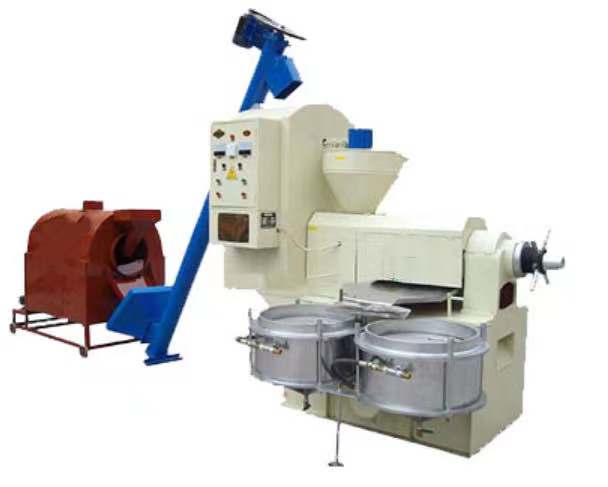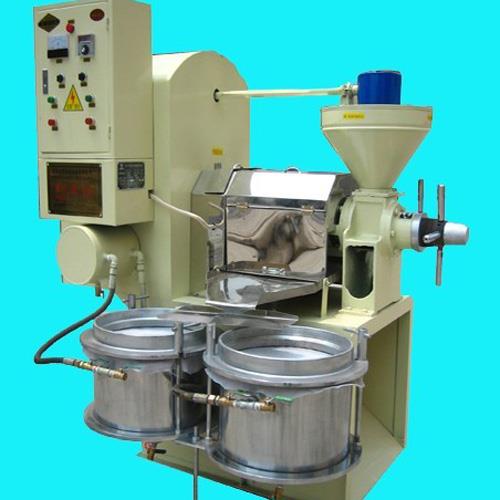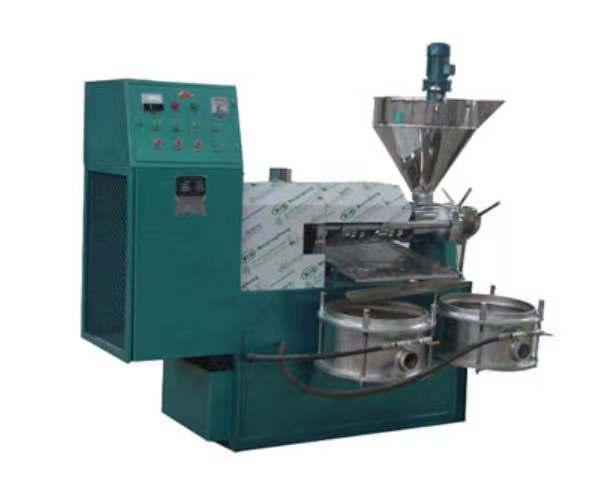As the name implies, the hot and cold oil press means that our oil press can be used as either a hot press or a cold press. In actual production, users can make reasonable choices based on their own needs. But it needs to be emphasized that although this machine can adapt to cold pressing, the productivity and oil yield of hot pressing are higher than cold pressing.

1. Working process of hot and cold oil press:
The hot and cold dual-purpose oil press is mainly composed of an electrical control part, a heating and pressing part, an adjustment part, a transmission part and a vacuum oil filtering part. The power transmitted by the main motor is transmitted to the main shaft through the reducer, and the screw screw mounted on the main shaft continuously advances the oil between the screws as it rotates. As the gap between the press chamber and the screw is gradually reduced, the density of the oil increases, and the pressure gradually increases. During the squeezing process, friction occurs between the oil particles, the oil and the parts, and heat is generated. This constitutes the pressure and heat of the oil squeezing process, destroying the cell tissue of the oil, and the oil overflows from the oil line. It is pushed out between the squeezing cone and the cake outlet. When the overflowing oil flows into the oil filter through the oil pan, negative pressure is formed in the barrel, and the oil passes through the filter cloth and is drawn into the oil filter barrel. The pure pressed crude oil is obtained at this time after being isolated on the filter cloth.
In addition, this hot and cold dual-purpose oil press adopts the optimized design of the press chamber with strips and round rows, and a forced feeding screw device is added to the hopper at the feed end, so that the oil enters the press chamber evenly, which is more conducive to ensuring the comparison of the press chambers. Good pressure value and high oil output rate. Compared with the single screw oil press, the press cage of this machine adds an automatic constant temperature heating device, which saves the mill preheating time when the temperature is low in winter. Set the temperature to stop working.

2. Advantages of hot and cold oil press:
(1) High oil output rate:
The hot and cold dual-purpose oil press adopts the principle of multi-stage propulsion and gradual pressurization, which can increase the pressure in the press chamber rapidly, so that the oil can be squeezed out at one time. At the same time, the infrared temperature control system is adopted to automatically control the pressing temperature and moisture, so that the oil is directly Soften and activate oil molecules, stable pressing, and the oil yield can be accelerated by about 10%.
(2) Wide use:
One machine with multiple functions, can squeeze more than 20 kinds of oil crops such as peanut, sesame, rapeseed, sunflower seed, castor bean, soybean and so on.
(3) Pure oil:
Equipped with a vacuum filter device to ensure the purity of the oil and meet the sanitary and quarantine standards.
(4) Small area:
The oil mill only needs 10-20 square meters to meet the production needs.
(5) Energy saving and labor saving:
The hot and cold dual-purpose oil press has low power, so the average daily power consumption is low; in addition, 1-2 people can organize production, which can save labor costs; overall, the cost of labor and electricity is relatively low, and it has the necessary economic advantages.

3. Technical parameters of hot and cold oil press:
|
Mode |
processing capacity (kg/h) |
Power (kw) |
size(mm) |
weight |
speed |
|
6YL-125 |
120-150kg/h |
15 |
1750*1700*1550 |
920kg |
110-120r/min |
|
6YL-150 |
200-250kg/h |
22 |
2600*1800*1800 |
1200kg |
110-120r/min |
|
6YL-168B |
280-300kg/h |
30 |
2600*1800*1800 |
1600KG |
30-40r/min |
|
6YL-208 |
350-400kg/h |
45 |
2600×1800×1800 |
1700KG |
110-120r/min |
4. Knowledge extension:
What is hot pressing? What is cold pressing? What is the difference between cold pressing and hot pressing? How to choose between cold pressing and hot pressing?
(1) The so-called hot pressing means that the oil is squeezed after heating. This type of squeezing method can be squeezed cleanly at one time. The oil cake produced has almost no oil content, so the oil cake is completely de-oiled cake. Can be used when the material cake. The advantage of hot pressing is that the squeezed oil is more mellow, and the oil that has been heated is more oily than cold pressing, but because it is hot pressing, the phenomenon of silting may occur during the pressing process. It should be noted that when pressing, do not be too anxious about feeding, and cut the material in an appropriate amount according to the oil output of the press.
(2) The so-called cold pressing means that the oil is sieved and then directly put into the oil press for squeezing without heating. This type of squeezing method is difficult to squeeze cleanly at a time, and the oil cakes produced also have oil content, and some This type of oil cake is required for one-time pressing, with less oil content, but not completely without oil. Then the advantage of cold pressing is that the color is relatively light, the oil will not foam when pressing, and there will be no silt phenomenon, and the color is better. The disadvantage is that the taste of the oil is not relatively fragrant, and it takes more than two times to squeeze it cleanly.
(3) The difference between hot pressing and cold pressing is mainly reflected in the processing technology (pressing method), oil yield, flavor, color and retention of nutrients.
(4) Hot pressing and cold pressing have their own merits, and customers can make a reasonable choice according to their actual conditions. But most of the vegetable oil we eat in our daily life is hot-pressed oil, which has a high rate of hot-squeezed oil, and the oil tastes mellow. And some oils are not suitable for cold pressing. Take soybeans, peanuts, and sesame seeds as examples. Soybean oil contains beany flavor, high erucic acid rapeseed oil's pungent flavor, cottonseed oil's gossypol toxin, and spoiled oil's yellowing. Aspergillus toxins, etc., need to be refined to be removed, and the aroma of sesame oil and peanut oil need to be obtained through a hot pressing process. The raw materials of the cold press must be carefully selected, otherwise due to the different maturity of the raw materials and the content of the raw materials The influence of harmful substances will have a serious impact on the quality of cold-pressed oil.
Copyright © Henan Zhongxing Grain And Oil Machinery Co.,Ltd. All Rights Reserved. Powered by MetInfo